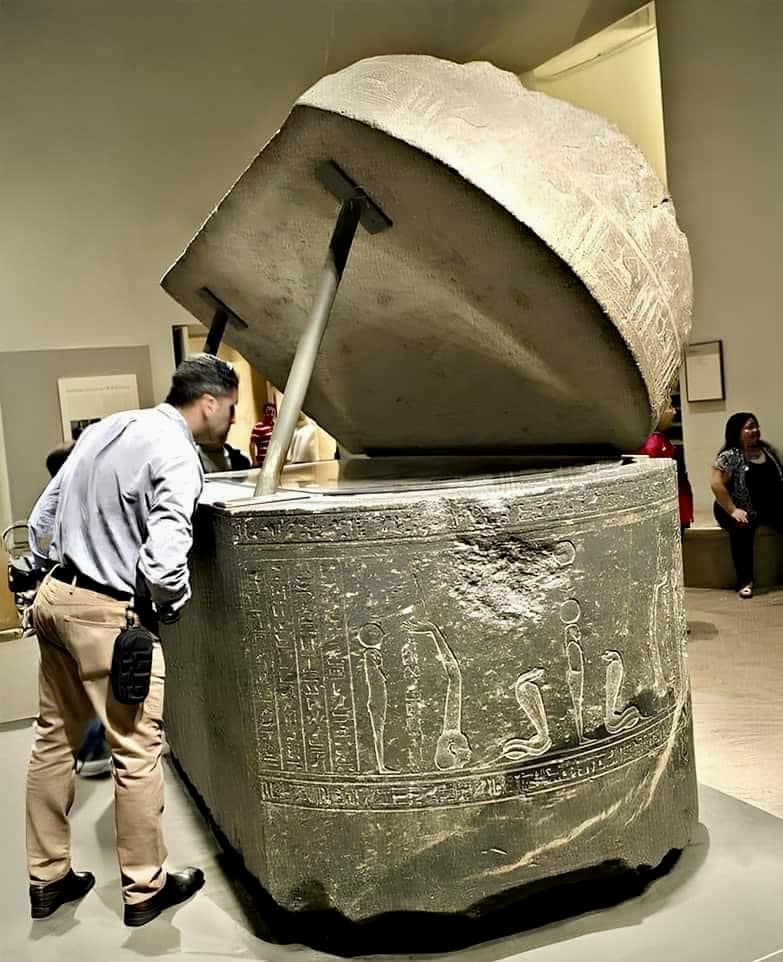In the heart of the Saqqara necropolis, among the vast desert sands and timeless monuments, one remarkable relic stands out—a colossal granite sarcophagus that not only captures the grandeur of ancient Egyptian craftsmanship but also reveals the depth of their spiritual and cultural beliefs. This massive funerary monument, belonging to the esteemed High Priest Wennefer, is more than a mere burial chamber; it is a monumental narrative carved in stone, a testament to religious devotion, social hierarchy, and an enduring philosophy of cosmic harmony.

Wennefer, a name of great significance in ancient Egyptian history, served as the High Priest of Ptah during the New Kingdom, a period noted for its flourishing art, culture, and monumental construction. The role of High Priest was no ceremonial formality; it was a position of immense influence and reverence. Ptah, the god of creation, craftsmen, and architects, was a central figure in Egyptian theology, and Wennefer, as his earthly representative, was charged with duties that extended far beyond temple rituals. He was not only the spiritual leader of Memphis, Egypt’s ancient capital, but also a pivotal figure in advising pharaohs and overseeing the maintenance of divine order.
The sarcophagus that housed Wennefer’s remains is awe-inspiring in both scale and detail. Measuring approximately four meters in length and weighing an estimated sixty tons, this granite marvel exemplifies the skill and dedication of ancient Egyptian artisans. Crafting such a massive object from solid granite—a stone notoriously difficult to work with even using modern tools—required advanced knowledge, precision, and immense labor. The fact that this was achieved over three millennia ago adds to the wonder and respect this monument commands today.
However, the sarcophagus is not merely impressive due to its physical dimensions. Every inch of its surface tells a story, etched meticulously into stone with intricate carvings and hieroglyphic inscriptions. These are not random decorations but carefully chosen symbols and narratives designed to ensure Wennefer’s safe passage into the afterlife. Scenes of divine judgment, offerings to the gods, and protective spells are prominently displayed, aligning with ancient Egyptian beliefs in the afterlife as a continuation of the soul’s journey. Each carving serves a purpose—whether invoking the protection of deities or symbolizing Wennefer’s piety and rightful place in eternity.
Central to the meaning of these inscriptions and the very design of the sarcophagus is the Egyptian concept of maat. Maat represented the fundamental order of the universe—truth, justice, balance, and harmony. The ancient Egyptians believed that maintaining maat was essential not only in life but also in death, and the detailed carvings on Wennefer’s sarcophagus reflect this philosophy. From the symmetry of the reliefs to the placement of divine figures, every element was designed to preserve cosmic balance and ensure that Wennefer’s soul would be judged favorably by Osiris, the god of the afterlife.
This sarcophagus, therefore, is more than a relic; it is a cultural and spiritual bridge to a society that viewed death not as an end, but as a crucial transition. The ancient Egyptians believed in a cycle of life, death, and rebirth, with elaborate rituals and artifacts aimed at facilitating a smooth journey to the afterlife. The size and detail of Wennefer’s sarcophagus indicate his high status and the importance placed on ensuring his spiritual wellbeing beyond this world. It speaks volumes about a civilization deeply invested in the metaphysical, one that poured extraordinary resources and talent into securing a future beyond death.
Today, this sarcophagus stands not only as a masterpiece of ancient engineering but also as a rich source of insight into Egyptian religious practices and social structure. Through its artistry, we glimpse the reverence with which the ancient Egyptians regarded their deities, the meticulous nature of their burial customs, and their belief in the soul’s journey. It underscores their mastery in working with stone, their devotion to religious expression, and their desire to immortalize the individual within the grand cosmic scheme.
As we reflect on Wennefer’s sarcophagus, we are reminded that archaeology is not just about studying objects but about uncovering human stories—stories of power, belief, and the quest for meaning. Behind each carving lies the touch of an artisan, the faith of a people, and the timeless human desire to understand existence and our place in the cosmos. The monument’s silence is profound, not because it lacks a voice, but because it speaks across millennia in the universal language of awe, reverence, and wonder.
In conclusion, Wennefer’s sarcophagus is more than a testament to the magnificence of ancient Egyptian civilization. It is a tangible link to a culture that achieved greatness not only in architecture and art but also in philosophical and spiritual thought. It continues to inspire archaeologists, historians, and laypeople alike, offering a window into a world where life and death were intertwined in a cosmic balance. In this colossal granite tomb, we find not only the remains of a revered priest but also a powerful reminder of humanity’s enduring quest for legacy, meaning, and connection to the divine. It is a legacy that has withstood the passage of time, calling on us to listen, learn, and marvel at what the ancients left behind.





